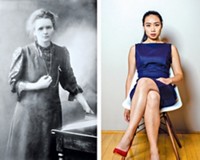Advertisement
Grab your lab coat. Let's get started
Welcome!
Welcome!
Create an account below to get 6 C&EN articles per month, receive newsletters and more - all free.
It seems this is your first time logging in online. Please enter the following information to continue.
As an ACS member you automatically get access to this site. All we need is few more details to create your reading experience.
Not you? Sign in with a different account.
Not you? Sign in with a different account.
ERROR 1
ERROR 1
ERROR 2
ERROR 2
ERROR 2
ERROR 2
ERROR 2
Password and Confirm password must match.
If you have an ACS member number, please enter it here so we can link this account to your membership. (optional)
ERROR 2
ACS values your privacy. By submitting your information, you are gaining access to C&EN and subscribing to our weekly newsletter. We use the information you provide to make your reading experience better, and we will never sell your data to third party members.
K-12 Education
Protein models are literally on the tips of students’ tongues
Bite-size molecular models could lower barriers to learning chemistry for students who are blind or visually impaired
by Sam Lemonick
May 28, 2021
| A version of this story appeared in
Volume 99, Issue 20

Many chemistry and biochemistry textbooks include thousands of pictures of molecules. These images help many students learn to recognize molecules and the structural features that affect their properties. But the reliance on pictures in teaching chemistry can be a hurdle for students who are blind or visually impaired.
Educators have long turned to physical models or raised images to teach molecular structures to blind or visually impaired students, but these can be expensive or impractical for large molecules like proteins. Biochemist Bryan Shaw and colleagues at Baylor University instead propose to use small, detailed models that students can touch with their lips and tongue (Sci. Adv. 2021, DOI: 10.1126/sciadv.abh0691).
The lips and tongue can distinguish features almost half the size fingers can, and researchers are exploring the idea of using the oral sense of touch as an alternative to visual stimuli for many possible uses. Shaw’s group used biocompatible resin to 3D-print protein models 2–20 mm in diameter—about the size of a rice grain or a peanut. They also cast edible, gumdrop-like, gelatin versions. The researchers even experimented with adding color and flavor to differentiate between proteins or between parts of proteins.

A total of 365 college and 31 elementary students, all of them sighted, tested the models. Some wore blindfolds and examined the models orally or with their fingers; the others saw rotating representations of the proteins on a computer screen. The students identified and remembered proteins about equally well, whether doing it orally, manually, or visually. Shaw thinks mouths are probably better than fingers for identifying small features like binding pockets, and they found some evidence of that in testing the smallest models.
Cary Supalo, a research developer at the Educational Testing Service who is blind, says the approach has merit and deserves further investigation. But of the researchers’ tests, he says, “being blindfolded is not equivalent to being blind.” Supalo suggests that the study might have benefited from collaborating with blindness organizations and including participants who are blind or have low vision.
Other educators also saw merit in the approach. Mona Minkara, a computational bioengineer at Northeastern University who is blind, called the idea “brilliant” but has not tried the models herself. Shaw is sending her some. She said, “If it works that would be a phenomenal problem to have solved.” The two hope to collaborate in future research on these models.
Kate Fraser, a high school science teacher at Perkins School for the Blind, tested the models and says they “definitely filled a need in my biology classroom.” She did not let her students put them in their mouths because of safety concerns, which Supalo also raised. But she did note promising results when they handled the models. She gave one student a model after a lesson on how substrates fit in enzymes’ binding pockets. When he found the pocket, she says, “I could almost see the light bulb going on over his head as he said, ‘Wow!’ ”





Join the conversation
Contact the reporter
Submit a Letter to the Editor for publication
Engage with us on Twitter